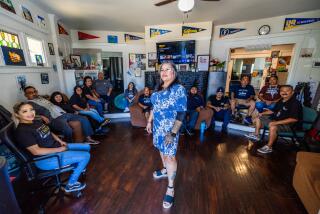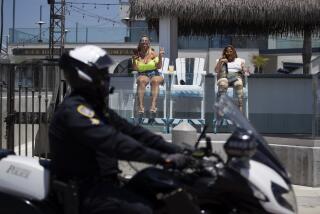A Hard-Edged Look at Life on L.A’s Mean Streets
- Share via
A thousand extra-duty patrolmen, backed by elite tactical squads and a special anti-gang task force, bring down the first act of “Operation HAMMER” on 10 square miles of South-Central Los Angeles between Exposition Park and North Long Beach, arresting more black youths than at any time since the Watts rebellion of 1965.
Like a Vietnam-era search-and-destroy mission--and many senior police are proud Vietnam veterans--Chief (Daryl) Gates saturates the street with his “Blue Machine,” jacking up thousands of local teen-agers at random like so many surprised peasants. Kids are humiliatingly forced to “kiss the sidewalk” or spread-eagle against police cruisers while officers check their names against computerized files of gang members.
There are 1,453 arrests; the kids are processed in mobile booking centers, mostly for trivial offenses like delinquent parking tickets or curfew violations. Hundreds more, uncharged, have their names and addresses entered into the electronic gang roster for future surveillance.
Gates, who earlier in the year had urged the “invasion” of Colombia (in 1980 he offered Jimmy Carter the LAPD SWAT team to liberate the hostages in Tehran), derided civil libertarian protests: “This is war . . . we’re exceedingly angry. . . . We want to get the message out to the cowards out there, and that’s what they are, rotten little cowards--we want the message to go out that we’re going to come and get them.” To reinforce the metaphor, but meaning it literally, the chief of the D.A.’s hard-core drug unit added: “This is Vietnam here.”
The “them”--what a local mayor calls “the Viet Cong abroad in our society”--are the members of local black gangs, segmented into several hundred fighting “sets” while loosely aligned into two hostile super-gangs, the Crips and the Bloods--universally distinguished, as every viewer of Dennis Hopper’s “Colors” now knows, by their color-coding of shoelaces, T-shirts and bandannas (red for Bloods, blue for Crips).
In the official version, which Hollywood is incessantly reheating and further sensationalizing, these gangs comprise veritable urban guerrilla armies organized for the sale of crack and outgunning the police with huge arsenals of Uzi and Mac-10 automatics. Although gang cohorts are typically hardly more than high school sophomores, local politicians frequently compare them to the “murderous militias of Beirut.”
Across town, or increasingly in South-Central itself, there is another large, traditional constituency of Latino gang membership, frequently depicted in the same lurid images. Indeed, the primary focus of gang hysteria in the 1970s was the rising violence among the third generation of East L.A. vatos locos (crazy guys). But a major community counteroffensive, unabetted by the police, and led instead by priests, parents and gang veteranos appealing to “Chicano unity,” managed to dramatically reduce Eastside gang killings from 24 in 1978 to zero in 1988. A major recrudescence of Latino gang warfare in recent days may be directly attributable to new liaisons with the crack trade.
If anything made ghetto turf rivalries so much more deadly than the Eastside’s during the 1980s, it was the incomparably higher economic stakes involved in control of the retail cocaine trade. “Gangbangin’ ” rose in a murderous arc from 1984 in rough synchronization with the emergence of crack as the narcotic equivalent of fast food and the rerouting of the main cocaine trail from Florida to Southern California via Mexico. Since the beginning of 1987, “gang-related” slayings, principally in Southside city and county areas, have averaged over one per day.
This very real epidemic of youth violence, with its deep roots in exploding youth poverty, has been inflated by law-enforcement agencies and the media into something quite phantasmagoric. In a numbers game that ceases to distinguish the authentic “high rollers” and “stone killers” of the gang world from the “claimers” and “wannabees,” the city attorney’s office has steadily escalated its estimates of hard-core gang membership from 10,000 to 50,000. Local media have amplified this figure to 70,000-80,000, while sheriff’s “gang experts” have invoked the specter of 100,000 “rotten little cowards” overruning Los Angeles County. Meanwhile, an Andromeda strain of Crips and Bloods is reported to have infected the entire West, from Tucson to Anchorage, before invading Middle America itself (with new sightings from Kansas City to Buffalo).
Like the tramp scares in the 19th Century, or the Red scares in the 20th, the contemporary gang scare has become an imaginary class relationship, a terrain of pseudo-knowledge and fantasy projection. But as long as the actual violence was more or less confined to the ghetto, the gang wars were also a voyeuristic titillation to white suburbanites devouring lurid imagery in their newspapers or on television.
Then in December, 1987, frisson became fear as Southside gang hit-men mistakenly gunned down a young woman outside a theater in the posh Westwood Village entertainment district near UCLA. Westwood’s influential merchants, who had recently induced the LAPD to enforce curfew ordinances to repel nonwhite youth from the village, clamored for extra police protection, while local Council member Zev Yaroslavsky, then essaying a challenge to Mayor Bradley, posted a huge reward for apprehension of the “urban terrorists.”
The dramatically different press coverage of, and preferential police response to, the Westwood shooting ignited the simmering resentment of black community leaders, who blasted Yaroslavsky, Bradley and the LAPD for failing to respond comparably to the mayhem in their neighborhoods.
For several weeks the council chambers resounded to an arcane debate over relative police response times in different divisions and the comparative allocations of department personnel. This ideologically circumscribed and loaded debate, focusing exclusively on the demand for a more equal and vigorous prosecution of the war against gangs, was a cue for the ambitious and media-hungry chief to reclaim center stage.
From “City of Quartz: Excavating the Future in Los Angeles,” by Mike Davis, 1990, Verso.
More to Read
Sign up for Essential California
The most important California stories and recommendations in your inbox every morning.
You may occasionally receive promotional content from the Los Angeles Times.










